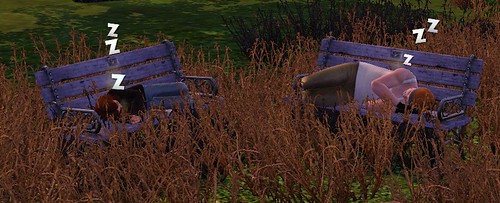Modding, Machinima, and Motion Capture
Areas of creative digital expression that relate directly to games.
Games have driven advances in technology that enable creative people to tell stories in ways that would previously have been impossibly expensive. Of course, the fact that the untrained masses can produce content with a few clicks does not guarantee that every creative effort is a masterpiece -- in fact most if it is forgettable. But the right tools do permit ordinary people -- even those who are not programmers -- to create extraordinary things.
Sims Stories
The creators of The Sims did not expect that users would take
screenshots, post them to fan pages, and use them as the framework for
storytelling. As the developers realized that fans were doing this on their own, they encouraged the practice within the game.
This past summer, Robin Burkinshaw "a student of games
design in the UK" created two sims, took away their house, and told a
story about what happened to them. He posted the story in installments
on a blog, "Alex and Kev."
If you want to create your own Alice & Kev fan fiction, you can
even download the characters and tweak their environment, to try to
achieve a different story.

Modding
In its simplest form, modding is creating additional content for existing games. In the 90s, fans of DOOM could create and share their own levels. For much of the 90s, this kind of thing was in a legal gray zone, since copyright owners weren't always comfortable with the idea of other people messing with their files.
But modding also means changing ("modifying") the rules of the game.
Authors of early text-adventure games would encrypt their data files, in order to make it harder for casual gamers to cheat. The additional challenge of hacking the software to look for hidden "Easter eggs" was part of the fun of playing a game. We see a echo of that historical experience in the concept of "cheat codes" -- built-in power-ups designed to give hard-core gamers additional reason to keep paying a game.
Game designers realized that the longer the hard-core gamers remained interested in a title, the more copies the game would sell.
Half-Life 2 comes with a free editing tool that lets users create their own maps. Power users can edit the bitmap textures, either by crudely adding smiley faces or targets on their enemies, or adding the faces of people they know into the game world.
HL2 is a sci-fi combat game. The editing tool that comes with the game is so powerful that a group of fans completely rebuilt the game as a World War II simulator -- replacing the futuristic weapons with historical pieces, the horror- and sci-fi props and settings with realistic historical ones. The result grew so popular that it was released as a commercial title, Day of Defeat.
(After I got stuck in HL2 in 2006, I stopped playing the game and dabbled with my own mod. I reported on my progress over several weeks... see Week 1, Week 6, and Week 10.)
A very popular do-it-yourself strategy for using a computer to tell a story is to build on the framework of a coputer game -- "machinima" (for "machine" + "animation").
The long-running "Red vs. Blue" series uses in-game footage from Halo to assemble a story. It started out as little more than a lark in 2003, but the series has continued for years and been released on DVDs.
Motion Capture
First drawing serious mainstream attention in the character Gollum from the Lord of the Rings movies, motion capture technology involves an actor wearing a special suit, performing motions that a computer records. The angle of their limbs, the position of their body parts, and the speed and direction in which all the parts move can be mapped to a 3D computer-generated character, which can result in animated CG images that convince our brains that what we are watching is more than a cartoon. (But if you've seen any publicity material on Avatar, you already know all this.)
When motion capture works, the effects are breathtaking. Here we see a few stages in the creation of Gollum.

The above image is from a a good analysis of the weaknesses of a motion-capture system that's not employed very well. The characters in The Polar Express seem stiff and waxy.
The Uncanny Valley
When animation is too real for our brain to process it as a cartoon, but not real enough for us to accept it on a deep, instinctive level; something seems wrong. We're trained to sense trouble when someone won't make eye contact with us, when their facial expression doesn't match their words, when they moving stiffly (perhaps because they've been injured by a hazard we haven't noticed yet).
If part of you is just a little creeped out by clowns, or china dolls, or you're amused by zombies and other undead, it's because those human-like creations fall along a line. To some extent, the more human-like something is, the better we respond to it. But at some point, when something looks very much like a normal human, but does not act like a normal human, our comfort level drops.
The term was coined by a robot designer, but it applies just as well to digital creations. (See Uncanny Valley.)

http://blogs.setonhill.edu/JeremyBarrick/2010/01/el_250_motion_capturing.html
http://blogs.setonhill.edu/KeithCampbell/2010/01/modding.html
http://blogs.setonhill.edu/MattTakacs/2010/01/mods.html
http://blogs.setonhill.edu/SusanCarmichael/2010/01/creative_ways_to_tell_stories.html
http://blogs.setonhill.edu/ElizabethSwartzwelder/2010/01/mods_are_great.html
http://blogs.setonhill.edu/JessicaKrehlik/2010/01/moddingsims_style.html
"Uncanny valley" is an easy trap to fall into with machinima production. While we now have the relative "luxuries" of realitime rendering and superfast development/production time, this is truly one of the challenges of this growing new field.